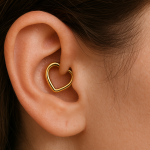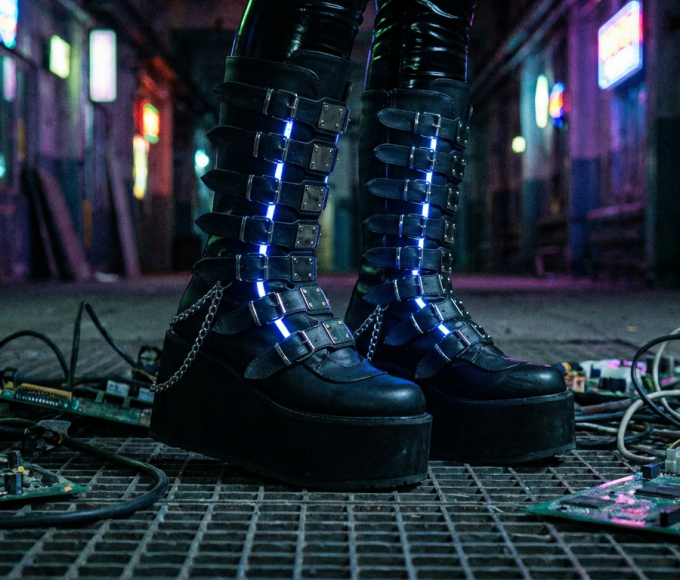So, you’re thinking about getting a surface piercing? Maybe a nape piercing caught your eye, or you’re vibing with a collarbone spark. Either way, before the needle hits the skin, you’re probably wondering: “How bad is the pain, really?” The pain levels of surface piercings can vary a lot, depending on location, technique, and even your own pain tolerance.
But don’t worry—we’re diving headfirst into the real talk about what it feels like to get a surface piercing, where it hurts the most, and how you can make the whole process a lot smoother. Let’s get into it!
What Are Surface Piercings, Anyway?
Before we dig into the pain levels of surface piercings, let’s get clear on what they actually are. Unlike traditional piercings that pass straight through a body part (like an earlobe or nostril), surface piercings go through a flat area of skin. Think of spots like:
- Nape of the neck
- Collarbone
- Hips
- Chest
- Wrist
- Hips
- Belly area
These piercings don’t go in one side and out the other like a hoop might. Instead, they sit under the surface layer of the skin using a surface barbell—a piece of jewelry specifically shaped to minimize pressure and promote healing.
So… Do Surface Piercings Hurt? Let’s Talk Pain
Ah, the million-dollar question: How bad is it gonna hurt?
Here’s the deal: surface piercings do hurt, but maybe not as much as you’d think. Since they go under a flat part of the skin instead of through thick cartilage or sensitive tissue, they’re often more manageable than, say, a septum or nipple piercing. That said, pain is subjective.
Factors That Affect Pain Levels
The pain levels of surface piercings can be influenced by:
- Location of the piercing – Some areas are more sensitive due to higher concentrations of nerve endings.
- Skin tightness and elasticity – Tighter skin may feel more pressure during piercing.
- Piercer’s technique – A skilled professional can minimize pain with clean, quick work.
- Your own pain threshold – Some people are just built different!
Ranking the Pain: Which Spots Hurt the Most?
Here’s a rough ranking based on what most people report (but remember, your mileage may vary):
- Least Painful:
- Hip piercings – Soft tissue, low sensitivity.
- Back of the neck (nape) – Feels like pressure more than pain.
- Moderate Pain:
- Chest piercings – Feels tight, slightly more nerve activity.
- Wrist – Thinner skin can sting a bit.
- Most Painful:
- Collarbone – Right over bone, can be intense.
- Belly area – More nerve endings and sensitive skin.
How Long Does the Pain Last
The good news? The worst of it is over quickly. You’ll feel a sharp pinch and some pressure during the actual piercing (usually done with a needle, not a gun—never a gun!). After that, there’s some swelling, maybe a bit of soreness, but it usually fades in a couple of days.
Expect some tenderness and mild discomfort for the first week or two, especially if you bump or snag the area. That’s why proper aftercare is key—more on that soon!
Tips to Make It Hurt Less
Want to take the edge off? You got it. Here are a few tips that can help dial down the discomfort:
- Choose a professional: An experienced piercer = less pain, faster healing.
- Stay hydrated: Water helps your body handle pain and heal quicker.
- Eat something beforehand: Low blood sugar can make pain feel worse.
- Breathe through it: Don’t hold your breath—slow exhales help your body stay calm.
The Healing Journey: What to Expect
Healing is a marathon, not a sprint. Surface piercings can take anywhere from 6 to 12 months to fully heal. That’s right—patience is a virtue here.
Common Healing Sensations:
- Tenderness
- Slight redness
- Itchiness (a sign of healing!)
- Clear or pale yellow fluid (totally normal)
But be on the lookout for signs of infection—like pus, severe swelling, or heat at the site. When in doubt, reach out to your piercer.
FAQs
Q: Can I use numbing cream to reduce pain?
A: You can, but most pros don’t recommend it. Numbing agents can interfere with the piercing process and healing.
Q: Is the aftercare painful too?
A: Not really. Cleaning might sting a little if the area is irritated, but with saline solution and gentle care, it’s totally manageable.
Q: Will it hurt more if I pierce a bony area?
A: Generally, yes. Areas like the collarbone are more painful due to their proximity to bone and nerve endings.
Q: How does it compare to other piercings?
A: It’s usually less painful than cartilage piercings but can be more uncomfortable during healing.
A Word on Rejection and Migration
Here’s the kicker—surface piercings are more prone to rejection. That means your body might push the jewelry out over time. It’s not always painful, but it can be annoying and disappointing.
Reduce the chances of rejection by:
- Using the right jewelry (titanium is a top pick)
- Following aftercare instructions
- Avoiding trauma (no tight clothes, no tugging!)
So, when it comes to the pain levels of surface piercings, the verdict is this: yes, there’s some discomfort, but it’s usually brief and totally worth it for the bold, head-turning look you get in return.
Each person’s experience is a little different, but if you go in informed and prepared, you’ll be able to handle it like a champ. Just remember—don’t skimp on the piercer, take your aftercare seriously, and listen to your body.
Alicia
Alicia is a passionate writer with degrees in English and American Literature. Her journey through the worlds of fashion, culture and design is as fascinating as her literary pursuits. Beyond literature, Alicia is equally an optimist who loves life. Whether it's photography, knitting, pottery, or yoga, she's willing to try it all. Beyond trends and labels, she advocate for sustainability and ethical fashion practices. She believe in the power of conscious consumerism, and she strives to highlight brands that prioritize environmental responsibility and social impact.
Recent Posts
Your Goth Christmas Style Guide
11/25/2025Cybergoth Aesthetic
11/11/2025Categories
Related Articles
Acubi Fashion: The Ultimate Guide to the Minimalist Edgy Look
In the fast-moving world of digital trends, fashion cycles seem to refresh...
ByAlicia12/25/2025Moss & Misdemeanor: Fairy Grunge Style and Outfits
The fashion world constantly mixes ideas to create new, unique looks. The...
ByAlicia11/18/2025Cybergoth Aesthetic
The alternative landscape is constantly evolving, but few aesthetics hit as hard...
ByAlicia11/11/2025Clean Goth vs. Trad: Mastering the New Minimalist Style
The world of alternative fashion is always changing, and a new look...
ByAlicia10/21/2025












Leave a comment